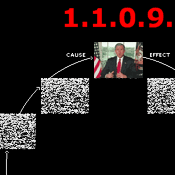 |
|
 |
 |
 |
 |
 |
  |
webwork 1
1.1.0.9.
cause & effect,
by Andrey VELIKANOV (Russia), 2002
 Another syllogism. All cats die. Socrates is Dead. Therefore Socrates is a cat.
Another syllogism. All cats die. Socrates is Dead. Therefore Socrates is a cat.
- The Logician, from Eugène Ionesco's Rhinocéros (1959)
On the morning of September 11th two planes crashed into the World Trade Center, one crashed into the Pentagon, and a fourth crashed in a field in Pennsylvania. That afternoon CNN was reporting that Osama Bin Laden was involved in the attacks. That evening CNN reported there were large explosions in Kabul, Afghanistan. Though they carefully avoided confirming who was responsible for the explosions, from my position in front of the TV the cause and effect conclusion seemed clear: Osama Bin Laden attacked the United States, Osama Bin Laden was believed to live in Afghanistan, therefore the United States attacked Afghanistan.
Yet my logic brought me to a faulty conclusion: US officials later told CNN that the United States had no role in the incident, and CNN reported that the Northern Alliance had blown up a Taliban arms depot in their ongoing civil war.
In Andrey Velikanov's website 1.1.0.9. the artist presents an effectively endless, randomly selected series of animated images. Each image is visually connected by directional arrows, which start at the word "CAUSE", and end at "EFFECT". There are roughly ten different templates, and after about five or so pages the images begin to repeat. The images come from the news footage from September 11th, Osama Bin Laden's tapes, Hollywood horror and science fiction movies, images of airplanes, images of war, etc. The images are small enough, and they flicker so fast that you often cant make out the details in the image: they are a convulsion of explosions.
In Velikanov's visual language my faulty logic occurs in extensively varying sequences of images. In one such sequence I encountered, an image of flight 175 crashing into the world trade center points to Bin Laden speaking, which points to an image of a policeman (I assume in New York on September 11th, though this is not clear), which points to President Bush speaking, which points to night-vision green explosions on CNN. His version of my sequence ends there, but his continues on, weaving other stories and histories into his timeline: The CNN image points to and image from the film Independence Day where the White House is exploding from an alien laser beam, which points to a "missile lock" graphic, which points a Hollywood starlet, which points to Arab men shaking their fists.
Velikanov explodes the possibility that any one event causes another. The potential for truth in the chronology of images is absurd, even before you start including images from films: it is intentionally simplistic, repeating images early in the user's experience. It is through the absurdist simplicity that he foregrounds the complexity of the situation.
At the same time, the presence of images from films opens up the possibility (if not probability) that our stories affect our histories. I could speculate that Will Smith's character in Independence Day could have inspired members of the American military, but why speculate: ominously, the Marines invaded Falluja blaring the music from Francis Ford Coppola's classic Vietnam film Apocalypse Now.
Velikanov incorrectly answers questions in order to interrogate the conventional answers to those same questions. He helps us understand the complexities of questions like, why did the attacks of September 11th happen, how President Bush was able to convince the American public to support a war with Iraq when their was no cause and effect relationship between Iraq and the attacks of September 11th, and how will history treat this moment?
Michael Mandiberg

 top top
 back back
|
|
 |
 |
 |
|
